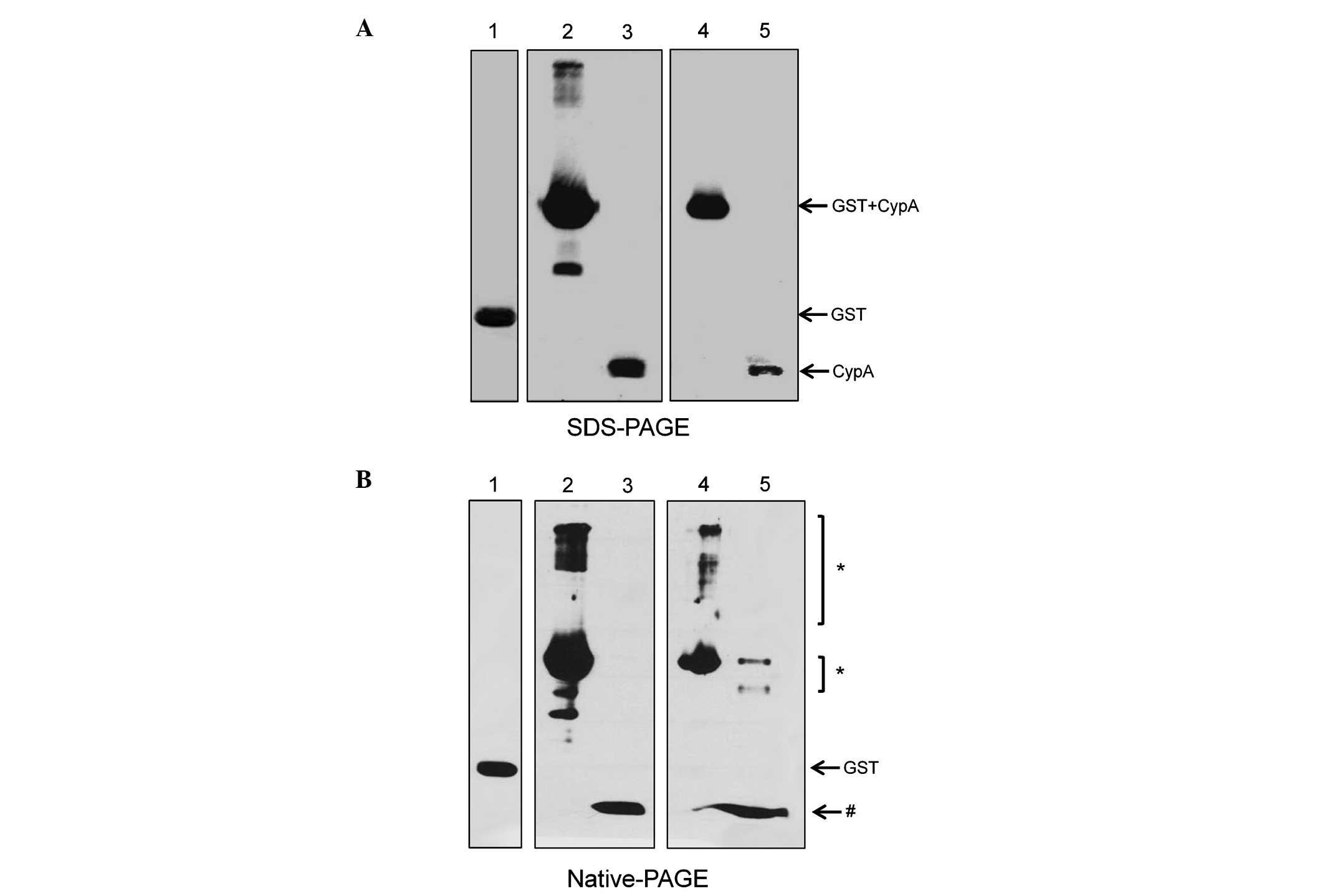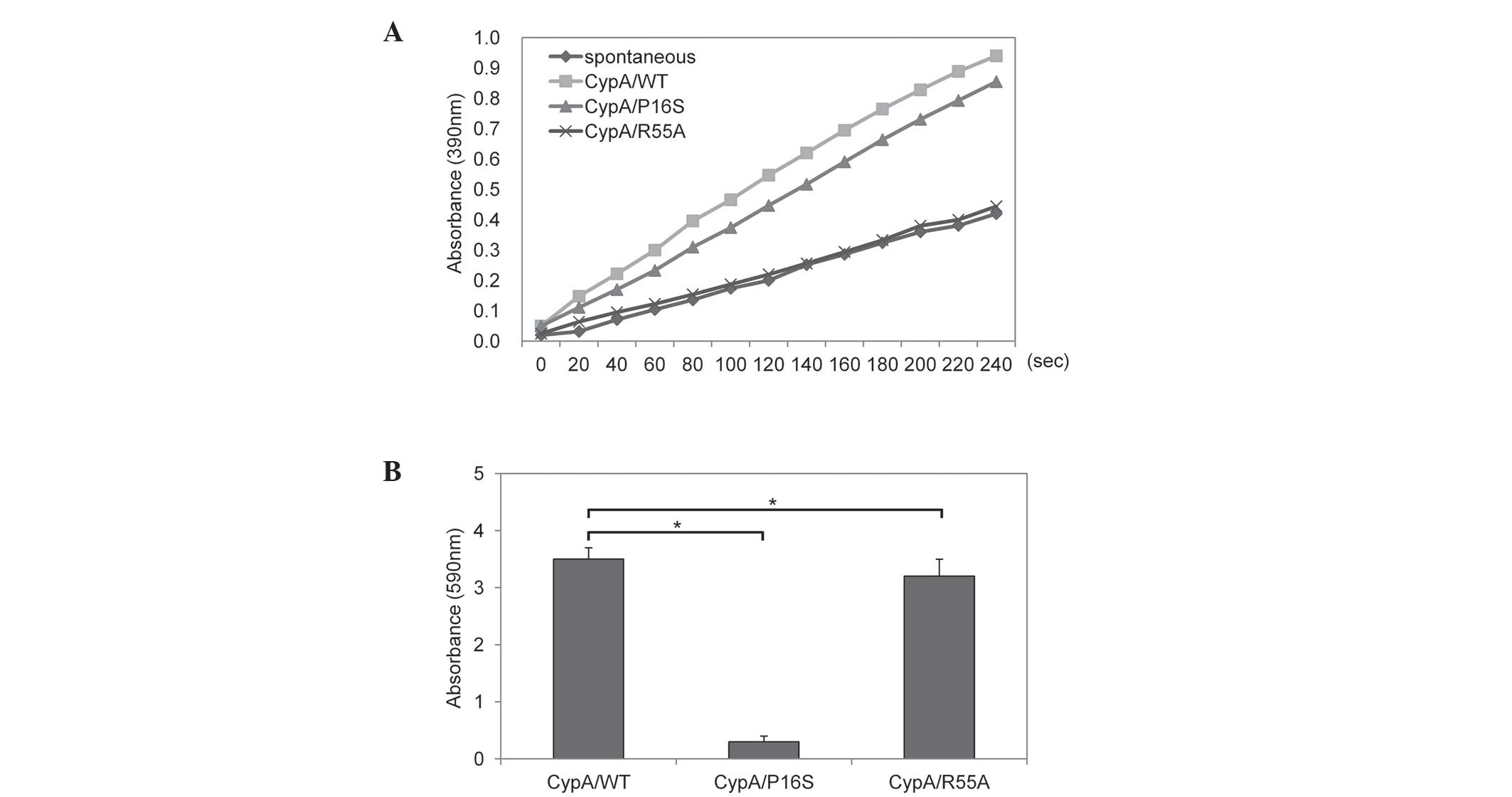|
1
|
Handschumacher RE, Harding MW, Rice J,
Drugge RJ and Speicher DW: Cyclophilin: a specific cytosolic
binding protein for cyclosporin A. Science. 226:544–547. 1984.
View Article : Google Scholar : PubMed/NCBI
|
|
2
|
Caroni P, Rothenfluh A, McGlynn E and
Schneider C: S-cyclophilin. New member of the cyclophilin family
associated with the secretory pathway. J Biol Chem.
266:10739–10742. 1991.PubMed/NCBI
|
|
3
|
Andreeva L, Heads R and Green CJ:
Cyclophilins and their possible role in the stress response. Int J
Exp Pathol. 80:305–315. 1999. View Article : Google Scholar
|
|
4
|
Wang P and Heitman J: The cyclophilins.
Genome Biol. 6:2262005. View Article : Google Scholar : PubMed/NCBI
|
|
5
|
Price ER, Zydowsky LD, Jin MJ, Baker CH,
McKeon FD and Walsh CT: Human cyclophilin B: a second cyclophilin
gene encodes a peptidylprolyl isomerase with a signal sequence.
Proc Natl Acad Sci USA. 88:1903–1907. 1991. View Article : Google Scholar
|
|
6
|
Schneider H, Charara N, Schmitz R, et al:
Human cyclophilin C: primary structure, tissue distribution, and
determination of binding specificity for cyclosporins.
Biochemistry. 33:8218–8224. 1994. View Article : Google Scholar : PubMed/NCBI
|
|
7
|
Carpentier M, Allain F, Haendler B, et al:
Two distinct regions of cyclophilin B are involved in the
recognition of a functional receptor and of glycosaminoglycans on T
lymphocytes. J Biol Chem. 274:10990–10998. 1999. View Article : Google Scholar : PubMed/NCBI
|
|
8
|
Harding MW, Handschumacher RE and Speicher
DW: Isolation and amino acid sequence of cyclophilin. J Biol Chem.
261:8547–8555. 1986.PubMed/NCBI
|
|
9
|
Choi KJ, Piao YJ, Lim MJ, et al:
Overexpressed cyclophilin A in cancer cells renders resistance to
hypoxia- and cisplatin-induced cell death. Cancer Res.
67:3654–3662. 2007. View Article : Google Scholar : PubMed/NCBI
|
|
10
|
Xu LR, Yan X, Luo M, Guan YX and Yao SJ:
Preparation, characterization and refolding in vitro of a
recombinant human cyclophilin A mutant: effect of a single Pro/Ser
substitution on cyclophilin A structure and properties. Biotechnol
Prog. 24:302–310. 2008. View Article : Google Scholar : PubMed/NCBI
|
|
11
|
Helekar SA and Patrick J: Peptidyl prolyl
cistrans isomerase activity of cyclophilin A in functional
homo-oligomeric receptor expression. Proc Natl Acad Sci USA.
94:5432–5437. 1997. View Article : Google Scholar
|
|
12
|
Morita T, Kawabata T, Horikawa N, et al:
Therapeutic consideration of patients with mental diseases. Seishin
Shinkeigaku Zasshi. 94:1092–1098. 1992.In Japanese.
|
|
13
|
Zydowsky LD, Etzkorn FA, Chang HY, et al:
Active site mutants of human cyclophilin A separate peptidyl-prolyl
isomerase activity from cyclosporin A binding and calcineurin
inhibition. Protein Sci. 1:1092–1099. 1992. View Article : Google Scholar : PubMed/NCBI
|
|
14
|
Gavin PD, Devenish RJ and Prescott M: FRET
reveals changes in the F1-stator stalk interaction during activity
of F1F0-ATP synthase. Biochim Biophys Acta. 1607:167–179. 2003.
View Article : Google Scholar : PubMed/NCBI
|
|
15
|
Fischer G, Bang H, Ludwig B, Mann K and
Hacker J: Mip protein of Legionella pneumophila exhibits
peptidyl-prolyl-cis/trans isomerase (PPlase) activity. Mol
Microbiol. 6:1375–1383. 1992. View Article : Google Scholar : PubMed/NCBI
|
|
16
|
Rahfeld JU, Schierhorn A, Mann K and
Fischer G: A novel peptidyl-prolyl cis/trans isomerase from
Escherichia coli. FEBS Lett. 343:65–69. 1994. View Article : Google Scholar : PubMed/NCBI
|
|
17
|
Rouvière PE and Gross CA: SurA, a
periplasmic protein with peptidyl-prolyl isomerase activity,
participates in the assembly of outer membrane porins. Genes Dev.
10:3170–3182. 1996. View Article : Google Scholar : PubMed/NCBI
|
|
18
|
Kofron JL, Kuzmic P, Kishore V,
Colon-Bonilla E and Rich DH: Determination of kinetic constants for
peptidyl prolyl cis-trans isomerases by an improved
spectrophotometric assay. Biochemistry. 30:6127–6134. 1991.
View Article : Google Scholar : PubMed/NCBI
|
|
19
|
Jiang Y, Guo C, Vasko MR and Kelley MR:
Implications of apurinic/apyrimidinic endonuclease in reactive
oxygen signaling response after cisplatin treatment of dorsal root
ganglion neurons. Cancer Res. 68:6425–6434. 2008. View Article : Google Scholar : PubMed/NCBI
|
|
20
|
Santos NA, Catao CS, Martins NM, Curti C,
Bianchi ML and Santos AC: Cisplatin-induced nephrotoxicity is
associated with oxidative stress, redox state unbalance, impairment
of energetic metabolism and apoptosis in rat kidney mitochondria.
Arch Toxicol. 81:495–504. 2007. View Article : Google Scholar : PubMed/NCBI
|
|
21
|
Marullo R, Werner E, Degtyareva N, et al:
Cisplatin induces a mitochondrial-ROS response that contributes to
cytotoxicity depending on mitochondrial redox status and
bioenergetic functions. PLoS One. 8:e811622013. View Article : Google Scholar : PubMed/NCBI
|
|
22
|
Kim J, Choi TG, Ding Y, et al:
Overexpressed cyclophilin B suppresses apoptosis associated with
ROS and Ca2+ homeostasis after ER stress. J Cell Sci.
121:3636–3648. 2008. View Article : Google Scholar : PubMed/NCBI
|
|
23
|
Hunter T: Prolyl isomerases and nuclear
function. Cell. 92:141–143. 1998. View Article : Google Scholar : PubMed/NCBI
|
|
24
|
Jin ZG, Melaragno MG, Liao DF, et al:
Cyclophilin A is a secreted growth factor induced by oxidative
stress. Circ Res. 87:789–796. 2000. View Article : Google Scholar : PubMed/NCBI
|
|
25
|
Pratibha R, Sameer R, Rataboli PV,
Bhiwgade DA and Dhume CY: Enzymatic studies of cisplatin induced
oxidative stress in hepatic tissue of rats. Eur J Pharmacol.
532:290–293. 2006. View Article : Google Scholar : PubMed/NCBI
|













